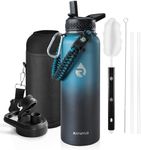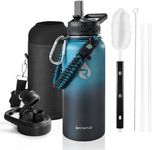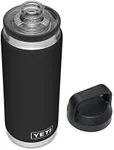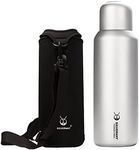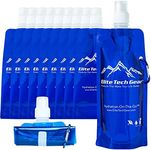Buying Guide for the Best Hiking Water Bottles
Choosing the right hiking water bottle is crucial for staying hydrated and comfortable during your outdoor adventures. The right bottle can make a big difference in terms of convenience, weight, and durability. Here are some key specifications to consider when selecting a hiking water bottle, along with explanations to help you make the best choice for your needs.MaterialThe material of the water bottle affects its weight, durability, and insulation properties. Common materials include plastic, stainless steel, and glass. Plastic bottles are lightweight and affordable but may retain flavors and odors. Stainless steel bottles are durable and can keep liquids hot or cold for longer periods, but they are heavier. Glass bottles are great for taste and cleanliness but are fragile and heavier. Choose a material based on your preference for weight, durability, and insulation.
CapacityCapacity refers to how much water the bottle can hold, typically measured in liters or ounces. Smaller bottles (up to 0.5 liters) are lightweight and easy to carry but may require frequent refilling. Medium bottles (0.5 to 1 liter) offer a balance between portability and sufficient hydration. Larger bottles (over 1 liter) provide ample water for longer hikes but can be bulky and heavy. Consider the length of your hike and your personal hydration needs when choosing the capacity.
WeightThe weight of the water bottle is important for overall comfort and ease of carrying. Lightweight bottles are easier to carry and reduce the load on your back, making them ideal for long hikes. Heavier bottles, especially those made of stainless steel or glass, may offer better durability and insulation but can add to the overall weight you need to carry. Balance the need for durability and insulation with the desire for a lighter load.
InsulationInsulation determines how well the bottle can maintain the temperature of your drink. Insulated bottles can keep liquids hot or cold for extended periods, which is useful for extreme weather conditions. Non-insulated bottles are lighter and more affordable but won't keep your drink at the desired temperature for long. If you plan to hike in very hot or cold environments, an insulated bottle might be a better choice.
DurabilityDurability refers to how well the bottle can withstand rough conditions and impacts. Plastic bottles are generally less durable but lightweight. Stainless steel bottles are highly durable and resistant to dents and scratches, making them suitable for rugged hikes. Glass bottles are the least durable and can break easily. Consider the terrain and conditions of your hike when choosing a bottle with the appropriate level of durability.
Ease of UseEase of use includes features like the bottle's lid design, mouth opening, and portability. Bottles with wide mouths are easier to clean and fill but may be harder to drink from while moving. Bottles with narrow mouths are easier to drink from but can be harder to clean. Look for bottles with secure, easy-to-open lids and consider whether you need features like a built-in straw or handle for convenience. Choose a design that fits your drinking habits and hiking style.
